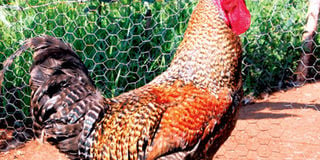New bird that grows faster and lays more

To anyone, the multi-coloured birds look like the ordinary indigenous chicken kept by nearly all households in western Kenya. PHOTO | LEONIDA WEKESA |
What you need to know:
- The poultry centre was established as a partnership between Bungoma County government and the Universities, Business and Research in Agricultural Innovation programme, which supports the setting up of innovation centres.
- According to Government-run National Farmer Information Service, poultry farming is facing many challenges, including lack of markets, high cost of inputs, loss of genetic diversity and low productivity.
- However, despite the wealth of knowledge about indigenous chicken among communities in western Kenya, experts say commercialising production will still require extra effort.
Leonida Wekesa, a retired teacher, feeds her new breed of chicken in a cage suspended about 2m above the ground in Kamukunda B Village on the outskirts of Bungoma town.
To anyone, the multi-coloured birds look like the ordinary indigenous chicken kept by nearly all households in western Kenya. However, these are Rainbow Roosters, a cross-breed of two high-yielding Indian chicken breeds.
The breed has all the features of local indigenous chicken, including taste, and has since adapted well in Kenya.
“I bought 100 three-day-old chicks from Mabanga Agricultural Training Institute’s Poultry Centre of Excellence two months ago and they have all survived,” she said.
The poultry centre was established as a partnership between Bungoma County government and the Universities, Business and Research in Agricultural Innovation programme, which supports the setting up of innovation centres.
Leonida is among thousands of beneficiaries who trained by experts from the centre on best practices in chicken rearing. This is part of the larger plan to commercialise indigenous and Rainbow Rooster chicken production once the ongoing construction of a chicken slaughterhouse in Chwele, Bungoma, is complete.
“The Luhya people know a lot about indigenous chickens given that the bird is part of their lifestyle and culture,” the director of the centre Oscar Makokha said. “However, what we are now doing is to make it a commercial venture so farmers can produce chickens in a structured manner for bigger markets locally and abroad.”
MANY CHALLENGES
According to Government-run National Farmer Information Service, poultry farming is facing many challenges, including lack of markets, high cost of inputs, loss of genetic diversity and low productivity. There are also issues of fluctuating production, diseases and inadequate funding and these are some of the challenges the poultry centre is addressing.
The centre is working with five farmers’ groups. Each group has 25 members who are trained on how best to keep both indigenous chicken and the Rainbow Roosters. They are trained on disease management, nutrition, use of technologies and marketing.
Makokha said farmers must be taught how to keep chickens for commercial purposes. The lessons should include managing emerging diseases.
However, despite the wealth of knowledge about indigenous chicken among communities in western Kenya, experts say commercialising production will still require extra effort.
“To produce chickens in huge quantities requires a lot of investment, thus, we need a lot if support,” said Dr Gregory Lukhale, Kapchai Sub-County veterinary officer.
The birds that will be processed at the slaughterhouse will have to be of given weight and in large quantities. The facility has a capacity to process 1,000 chicken per hour.
Leonida said the new breed feeds on sorghum, maize, insects, ugali, omena, collard green (sukuma wiki), which are locally available and to her, that is an advantage.
“They are exactly like the indigenous chicken only that they grow faster and lay more eggs compared to indigenous ones,” said the mother of five. The Rainbow Roosters lay up to 320 eggs in a lifecycle, compared to the 80 an ordinary indigenous chicken lays.
“We sell about 3,000 day-old chicks of the new breed every month, particularly to farmers who have been trained. The figure is set to go up once the abattoir is up and running.”





